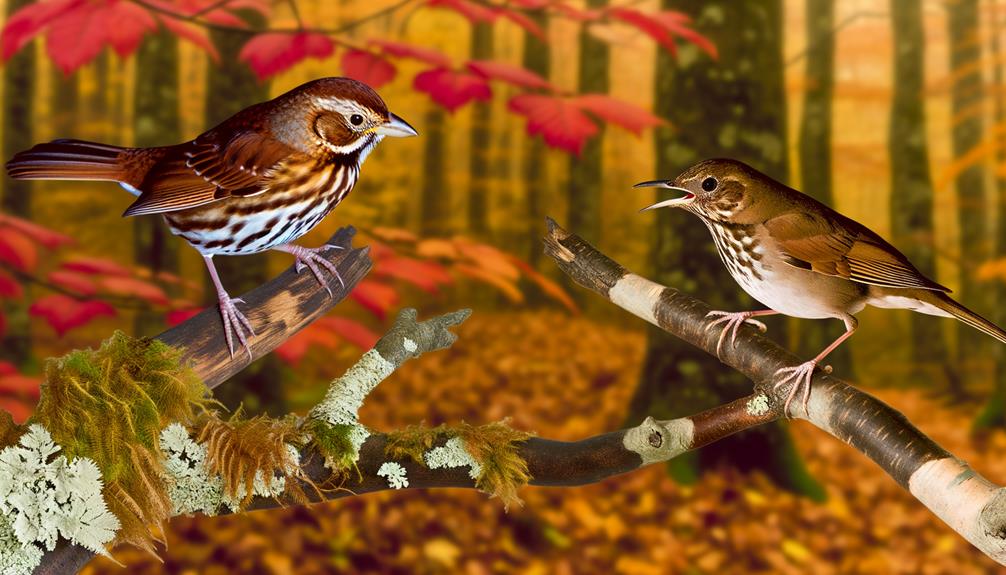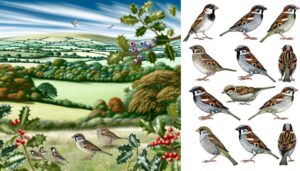7 Key Differences Between Fox Sparrow vs Hermit Thrush
The Fox Sparrow and Hermit Thrush differ in numerous ways. Size and color distinguish them physically; the Fox Sparrow is robust with reddish-brown hues, while the Hermit Thrush sports a smaller build, spotted breast, and reddish tail.
Songs vary too, the Fox Sparrow's being a simple whistle and the Hermit Thrush producing flute-like notes. Habitats also differ, with the Sparrow preferring dense shrublands and the contrary for the Thrush that gravitates to forest cover.
Their foraging styles highlight their uniqueness, with Sparrows ground-foraging, and Thrushes applying a 'hop-and-pause' method. The journey of comparison doesn't end here, there's more to explore.

Key Takeaways
- Fox Sparrows are robust, large songbirds with reddish-brown hues, while Hermit Thrushes have a brown upper body, reddish tail, and white eye-ring.
- Both birds have unique songs, with the Fox Sparrow's being a clear whistle with rapid notes and trills, while the Hermit Thrush's song is composed of ethereal, flute-like notes.
- Fox Sparrows prefer habitats with dense shrubs and thickets across North America, while Hermit Thrushes thrive in dense forests and shrublands, migrating to warmer areas in winter.
- Hermit Thrushes use a 'double-scratch' foraging method and communal defense strategies, while Fox Sparrows are adapted for ground foraging and show high adaptability to environmental changes.
- The pitch of the Hermit Thrush's song is often twice as high as that of the Fox Sparrow, indicating a significant difference in their vocal ranges.
Understanding the Fox Sparrow
Often seen in the dense undergrowth, the Fox Sparrow is a robust, large songbird that captivates birdwatchers with its vibrant plumage and melodic song. This impressive avian species is commonly identified by its size, typically larger than most of its sparrow counterparts, and its distinctive coat of reddish-brown hues, giving it its 'Fox' moniker.
Its song, a rich, melodious array of notes, is a signature trait. The Fox Sparrow's habitat spans across North America, from the dense forests of Alaska to the shrubs of California. It's specifically adapted to forage on the ground, using a unique two-footed, backward-scratching technique.
Known for its migratory behavior, it's seen mostly during winter months, adding a splash of color to the otherwise bleak landscape.
Basic Characteristics of Hermit Thrush
The Hermit Thrush, scientifically known as Catharus guttatus, presents unique features and behaviors of interest. Its physical appearance is marked by a brownish upper body, spotted breast, and a distinctly reddish tail, distinguishing it from similar species.
Observations of its behavior reveal it to be a solitary bird with a melodious song, preferring to forage on the ground in forested habitats.
Hermit Thrush Appearance
Sporting a rich brown upper body and a smoky-gray below, Hermit Thrush exhibits a distinct white eye-ring and reddish tail, setting it apart in the bird kingdom. Commonly measuring between 6-7 inches in length, it's a bird of moderate size.
The underparts display a unique spotted appearance, more prominent in adults than juveniles. The spots are usually dark, contrasting against the lighter belly and chest.
The bill of the Hermit Thrush is straight and slender, an adaptation aiding in their insectivorous feeding habits. The legs are a pale pinkish-brown, with sturdy feet adapted for both perching and ground foraging.
The bird's plumage often appears slightly ruffled, giving it a distinctive 'fluffy' look. These physical characteristics make the Hermit Thrush easily identifiable for birdwatchers and researchers alike.
Hermit Thrush Behavior
Moving beyond its distinctive physical characteristics, let's explore the behavior of the Hermit Thrush, a bird known for its unique habits and tendencies.
- Solitary Nature: The Hermit Thrush is a solitary bird, preferring to spend most of its time alone except during mating season.
- Foraging Habits: This species employs a 'hop-and-pause' method of foraging, hopping along the ground then pausing to scan the surroundings for food.
- Vocalization: Recognized for its melodious song, the Hermit Thrush often sings at dusk, its resonant notes carrying through the stillness.
The Hermit Thrush's behavior reflects its adaptation to its environment. Significantly, its solitary nature and foraging habits highlight its survival strategies, while its unique vocalization adds a beautiful complexity to its character.
Fox Sparrow's Natural Habitat
The Fox Sparrow boasts a geographic range that spans across North America, from the dense coniferous forests of Alaska to the scrublands of California. This diverse environment poses unique survival challenges, shaped by factors such as predation, food availability, and climate change.
In addition, the Fox Sparrow's habitat undergoes significant seasonal variations, with migration patterns influencing the species' survival and reproduction strategies.
Fox Sparrow's Geographic Range
Across North America, the Fox Sparrow primarily inhabits dense shrubs and thickets. Its geographic range extends from Alaska and Canada in the north to the western and eastern United States during its migratory periods. These birds are primarily observed in:
- The dense, coniferous forests of Alaska and Canada during the breeding season
- The scrublands and chaparral of the Western United States during migration
- The Eastern United States, where they winter in thickets and brushy areas
The Fox Sparrow's geographic distribution is intricately tied to its lifecycle and its ability to find best-suited habitats for breeding, feeding, and wintering.
Their migration routes are greatly influenced by environmental factors, demonstrating an impressive adaptation to the diverse climates and habitats across North America.
Environment and Survival Challenges
In the diverse ecosystems they inhabit, Fox Sparrows face a plethora of survival challenges, each demanding unique adaptations and resilience. These robust birds thrive in brushy habitats, often in close proximity to water bodies. Predation, food scarcity, and habitat degradation are primary threats.
They've evolved a cryptic plumage, blending seamlessly into the underbrush, reducing their visibility to predators. They're opportunistic foragers, feeding on a wide variety of insects, seeds, and berries, which helps them overcome food scarcity. Additionally, Fox Sparrows exhibit a high degree of adaptability to habitat changes, often exploiting human-altered landscapes.
However, severe habitat degradation, particularly due to intensive agriculture or urban sprawl, can exceed their adaptability threshold, leading to population declines.
Seasonal Habitat Variations
Fox Sparrows navigate through starkly contrasting habitats as each season unfolds, showcasing their adaptability and resilience. They can be found in different regions based on the time of the year, demonstrating a keen understanding of their environment and survival needs.
Their habitat preference varies in the following ways:
- During winter, they're commonly seen in coastal areas and the southern United States, where the climate is milder.
- Come spring, they migrate to northern regions or higher altitudes for breeding, preferring dense shrubs and forest undergrowth.
- In autumn, they shift to stopover sites for foraging and resting before the next migration.
These seasonal changes depict the Fox Sparrow's intrinsic ability to adapt, thereby ensuring survival amidst changing environmental conditions.
Hermit Thrush's Comfort Zones
Nestled within North America's dense forests and shrublands, the Hermit Thrush finds its ultimate comfort zone, exhibiting a distinct preference for these habitats over others. This bird's affinity for dense vegetation is likely due to the ample cover and food resources it provides, as well as the protection it offers from predators.
The Hermit Thrush is particularly partial to damp, mature forests with a mix of coniferous and deciduous trees, often found in the cooler northern regions during breeding season. Conversely, in winter, it seeks warmer comfort zones and migrates to southern states or even as far as Central America.
Its adaptive nature enables it to thrive in a variety of habitats, demonstrating its remarkable resilience and versatility.
Unique Behaviors of Fox Sparrow
Shifting our focus to the Fox Sparrow, we observe behaviors that are as unique as they're intriguing, particularly their method of foraging which involves a distinctive 'double-scratch' hopping motion. This tactic enables them to uncover hidden food resources in the ground cover, a reflection of their adaptability and resourcefulness.
Analyzing further, we reveal other notable behaviors:
- Fox Sparrows have a tendency for vigorous dust-bathing, an activity that helps them maintain healthy feathers.
- They're recognized for their melodious song, a complex and intricately patterned sequence that varies across different geographical populations.
- Unlike many birds, Fox Sparrows often spend their winters in the same area they breed, showing a certain loyalty to their home range.
This behavioral overview presents the Fox Sparrow as an intriguing species, rich in unique and adaptive traits.
Interesting Actions of Hermit Thrush
Exploring the realm of the Hermit Thrush, we encounter a species teeming with captivating behaviors that emphasize its adaptability and survival abilities. This bird displays a unique ground-foraging method, known as 'double-scratch,' where it moves forward while simultaneously flicking back soil to uncover insects. It's a characteristic that illustrates the bird's clever use of its surroundings to optimize food gathering.
In terms of interspecies interactions, Hermit Thrushes showcase a tactic of 'mobbing' to deter potential predators. They come together in groups, raise their wings, and emit harsh calls to intimidate intruders, displaying their communal defense strategy.
Lastly, their migratory patterns are remarkable for their extreme precision. They return to their breeding grounds with exceptional accuracy, a testament to their outstanding navigational skills.
Comparing Vocalizations and Songs
Delving into the vocalizations and songs of both the Fox Sparrow and the Hermit Thrush, we encounter a fascinating contrast in their auditory displays, each species boasting a unique blend of tones, rhythms, and patterns.
The Fox Sparrow, distinguished by its rich, resounding song, often repeats a simple, clear whistle. The Hermit Thrush, on the other hand, is renowned for its ethereal, flute-like notes, which create a haunting melody.
To further illustrate these differences:
- The Fox Sparrow's song generally consists of a series of rapid notes followed by a trill, creating a lively rhythm.
- The Hermit Thrush's song is more complex, often starting with a single, high-pitched note followed by a series of descending, melodious phrases.
- The pitch of the Hermit Thrush's song is often twice as high as that of the Fox Sparrow, demonstrating a significant difference in their vocal range.
Conclusion
To sum up, both the Fox Sparrow and Hermit Thrush exhibit distinct characteristics, habitat preferences, and behaviors.
The Fox Sparrow's sturdy build and melodious tunes contrast the Hermit Thrush's understated grace and celestial songs.
Each bird's individual traits mirror the varied ecosystems they reside in.
Their distinctions and resemblances offer a captivating glimpse into nature's intricacy, emphasizing the significance of comprehending and conserving such diversity in our avian world.






